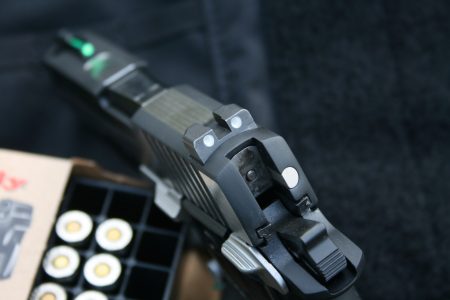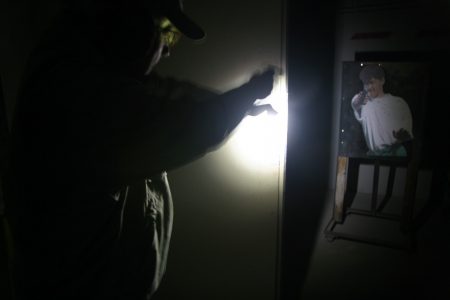Navigate This Post
3 Dot Sights
1030: Receive a phone call from a good friend in the industry. My friend explains that he is working with a company that is producing pistol sights. He informs me that his research indicates that 3 Dot Sights outsell all other pistol sights, 10 to 1, in retail outlets. I hang up the phone depressed.
1145: Begin to work on serious thought piece regarding handgun sights and how to explain the benefits and detriments of certain types of sights.

I have gone on record more than once that I am not a fan of 3 Dot Sights. That is, a front sight with a white (red, orange, yellow, etc) dot and a rear sight with two matching dots of the same size and color. Yes, some manufacturers will put a red dot up front and two white dots in the rear. Even worse.
Yes, I fully understand the purpose of the 3 dot style of pistol sights. They are basic level simple, Kindergarten level if you will. The brand new pistol shooter is told, “Put the front sight dot between the two rear dots. Hold the pistol still and press the trigger.” What could be easier?
Some proponents would say that 3 dot sights work instinctively with the human eyes. That it is a natural function to line up the three dots in a row. That is a dubious claim to be sure.
If you discuss this situation with experienced firearms instructors, most will tell you that when the shooters are focusing on lining up the dots, their shots invariably impact low on the target. Just how low depends on the shooter, the gun, and the distance.
Summary:
The tendency to shoot low aside, a reality that most people skip right over, is the fact that the human eye can only focus at a single distance at one time. With traditional sights, you have three objects in the field of view; rear sight, front sight, and target.
All experienced shooters should understand that it is the front sight that must be focused on as the shot is being made in order to deliver the bullet on to the desired part of the target. Pistol Shooting 101 is “Front sight focus, trigger press.”
Why do we use white, or orange, or red, or yellow/green dots on our sights? Because those color choices are easy for our eyes to pick out of all the other colors out there in front of us. The brighter the dot, the more it draws our eye. Herein lies the problem.
With traditional painted white dot sights, you have two white dots that are closer to the eye than the front white dot. Using the same color, the rear sight reflects more light and seems brighter to the eye. Therefore, the natural focus will go to the rear sight first. But, we are supposed to be focusing on the front sight. So we need to do that mental shift from rear to front.
XS Sight Systems has been trying to address this for decades. With Tritium night sights, if the Tritium vials are identical in the front and rear, the rear sight will be twice as bright. That is the reason most modern sight makers put more dim Tritium in the rear. However, if the rear sights are white dots with Tritium inserts we go back to the same issue. Fiber optic sights are much the same.

So, having explained all that science to you, you might wonder how 3 dot sights outsell all other sights 10 to 1. The answer is frustratingly simple.
The vast majority of shooters will never take the time to consider any of the realities we just considered. Most are stuck at the Kindergarten level of training or lack thereof. Also, and this is a pretty big also, the vast majority of handgun shooters do so in good light conditions under zero stress. These folks cannot see any problem with the 3 dot system. After all, they have ample light and ample time to line up their dots and make the shot.
Even those who claim to have purchased a gun for concealed carry or home defense will almost never use it in a scenario that would mimic the reality of a genuine life and death gunfight. My previous argument falls on deaf ears.
Initial Conclusion:
So, where does that leave handgun manufacturers and sight makers? Well, it is not their job to train and educate the consumer, it is they job to sell products. If the consumer is craving 3 dot sights because that is what they think they should have, why should the gear makers change that?
What we have is an endless perpetual cycle. The consumer says “Three dot sights must be the best choice because that is what Glock (or SIG, S&W, Springfield, etc) are putting on their guns.” Gun makers keep putting them on the guns because that is what the customer says they want.
As thus, here I sit, having learned how to properly use a fighting pistol 31 years ago and understanding the science of sight and human vision, pondering whether or not to simply throw my hands in the air and say “Screw it, buy 3 dots sights, I don’t give a damn.”
There is a new company called Night Fision that is making Tritium handgun sights. Perhaps they will have better luckeducating the masses than I. Time will tell.
Leave a CommentProfessor Paul Markel
Latest posts by Professor Paul Markel (see all)
- Tactical Rifle Tips: Transition Drills - January 5th, 2024
- 40/20/25 Shooting Drill - October 29th, 2023
- Working With Your Body Armor - October 3rd, 2023
- Hi-Point YC9: Yeet Cannon - August 14th, 2023
- Texas Hog Hunting: Day or Night w/ One Rifle - July 25th, 2023
I love sights with 3 white dots. It makes it easy to black out the rear dots with a marker. Then fill the front white dot with Testors Fluorescent Rose enamel.
You do realize that under low light that will just be a shade of gray darker than the white you covered up?
They gray is not as bright or distracting as white dots. The front rose dot stands out as well as any non radium sight can. IMHO.
I know you poo poo gun gamers but when you shoot action pistol games and you get decent you will learn that a high visibility front sight and plain black rear sight is the best arrangement. Solution: everyone shoot competition. ???? Thanks for the article.
so uh, what should we install?
Red dot all the wayyyy. You can have the pistol in a weird “stance” if you will but you line he red dot up on target and it will hit even if your front site is fixed and not on target trust the red dot (if it’s sited in)
Good article. XS Sights have no dots on rear sight. Yet they do have a line down the center. I believe at this time it is still tritium. The Ruger I carry has 3 dot with the rear dots covered in black soot. The TP9SFelite has 3 dot. Soon to be changed to XS Sights Big Dot. I will see how distracting the line is on the rear sight.
I know Paul Markel uses XS Sights, however he did not mention how distracting the line was. Still, it maybe necessary. and we practice to learn how to use the gear we have.
Paul never said the XS Sights rear sight line was distracting.
My bad, I meant to say that I have not heard him say anything about the line on the rear sight.
The value of “how distracting” could be from zero to 100% depending on how it effects you at the time. In most cases it is an individual assessment. Some don’t need to black out the rear sight at all, some need to paint over them because it’s just too big of a distraction.
My sights should arrive sometime next week. At that time, once installed, I can make an assessment of how it affects me or doesn’t. It still would be interesting to know if the line had any effect good or bad on Paul or even you and how you or Paul delt with in.
Found this after Googling 3 dot sights mess up my eyes. I agree, they suck.
Glad to have you with us, Michael. If you haven’t seen this video yet, it’s one of our most popular: https://www.facebook.com/studentofthegun/videos/1107456376010028/
My Canik TP9SFX only has the one red dot (fiber optic) up front and no rear dots THANK GOD.